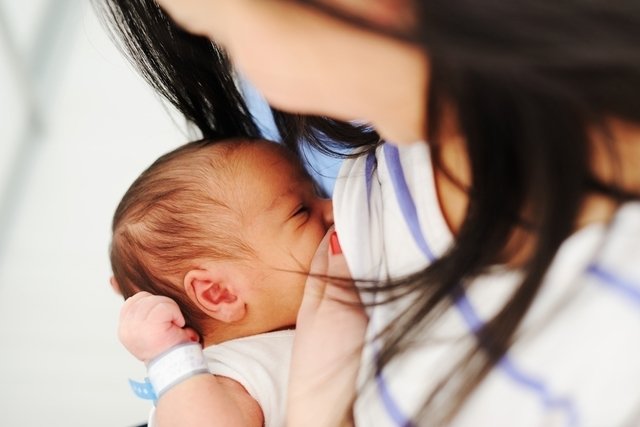During pregnancy, the breasts naturally prepare for breastfeeding, as the mammary ducts and milk-producing cells develop, in addition to there being greater blood supply to the area, causing the breasts to grow throughout pregnancy.
Despite being a natural process, preparing the breast for breastfeeding by adopting some simple precautions, such as washing the breasts with just water and massaging them, and making sure the baby is correctly positioned and latched on while breastfeeding, can prevent problems such as cracks or fissures in the nipple.
If you have difficulty preparing your breast for breastfeeding, you can consult an obstetrician, pediatrician or other professionals specialized in breastfeeding for an assessment and further guidance on the measures to be adopted.

Therefore, to prepare the breast for breastfeeding, it is important:
1. Wash the breast with just water
Breasts and nipples should only be washed with water and dried carefully after bathing. Therefore, the use of soaps or creams is not recommended, because the nipples have natural hydration that must be maintained during pregnancy and these products can remove it, increasing the risk of cracked nipples.
A tip to keep your nipples hydrated and avoid cracking is to use your own milk as a moisturizer after feedings.
2. Wear your own bra
During pregnancy, it is recommended to wear a comfortable, cotton bra with wide straps and good support. It is also important that the bra does not hurt the breasts and that they can remain completely inside the bra.
Furthermore, the nursing bra can be used from the third trimester so that the pregnant woman can get used to it and learn how to use it, before using it for the first time.
3. Sunbathing on your nipples every day
It is recommended to get around 15 minutes of sunlight per day on your breasts, preferably before 10am or after 4pm, as this helps prevent cracked nipples and nipple candidiasis. Furthermore, it is important to use sunscreen on your breasts, except for the areolas and nipples. Understand better what nipple candidiasis is and its treatment.
4. Massage the breasts
Before each feeding, it is recommended to massage the entire breast using circular movements, especially over the most hardened areas, if any. Massage helps prepare the breast for breastfeeding, making the milk more fluid and stimulating the production of the hormone oxytocin, which promotes milk flow.
Furthermore, when the nipple is more tense, expressing the breast after massage until a little milk appears in the nipple helps the milk let down. Milking can be done by carefully pressing the base of the breast between the index and thumb fingers and moving them towards the nipple.
Sometimes, inverted nipples can be stimulated so that they face outwards, making breastfeeding easier. To do this, you can use a syringe and then massage, rotating the nipples. Learn how to breastfeed with inverted nipples.
5. Airing the nipples
It is important to air the nipples several times during the day, as this allows the skin to breathe, preventing the appearance of cracks or fungal infections.
Other breast care
Correct positioning of the breast for breastfeeding is also important to avoid discomfort and prevent fissures or cracks in the nipples. It is important that a good part of the nipple is inside the baby’s mouth during breastfeeding.
Furthermore, when the latch is correct there is no pain, the baby’s lower lip is turned outwards, his chin is touching the breast and it is possible to see a small part of the nipple above his mouth.
Other important breast care includes:
- Do not use ointments, moisturizing creams or other products on the areola or nipple;
- Do not rub your nipples with a sponge or towel;
- Do not douche your nipples;
- Do not express milk with your hands or a pump during pregnancy.
These precautions must be maintained throughout pregnancy and breastfeeding, as they prevent possible injuries to the nipples. See how to solve the most common breastfeeding problems.
Bibliography
- BURNS, Dennis A. R. et al. Textbook of Pediatrics of the Brazilian Society of Pediatrics . 4th ed. Barueri, SP: Editora Manole, 2017. 328-338.
- SINGH, Nilanchali. Breast Stimulation in Low-Risk Primigravidas at Term: Does It Aid in Spontaneous Onset of Labour and Vaginal Delivery? A Pilot Study. Biomed Res Int. 2014
- JOHNSON, Teresa S; STRUBE, Karen. Breast Care During Pregnancy. Journal of Obstetric, Gynecologic & Neonatal Nursing. Vol.40, n.2. 144-148, 2011

Sign up for our newsletter and stay up to date with exclusive news
that can transform your routine!
Warning: Undefined array key "title" in /home/storelat/public_html/wp-content/plugins/link-whisper-premium/templates/frontend/related-posts.php on line 12
Warning: Undefined array key "title_tag" in /home/storelat/public_html/wp-content/plugins/link-whisper-premium/templates/frontend/related-posts.php on line 13




